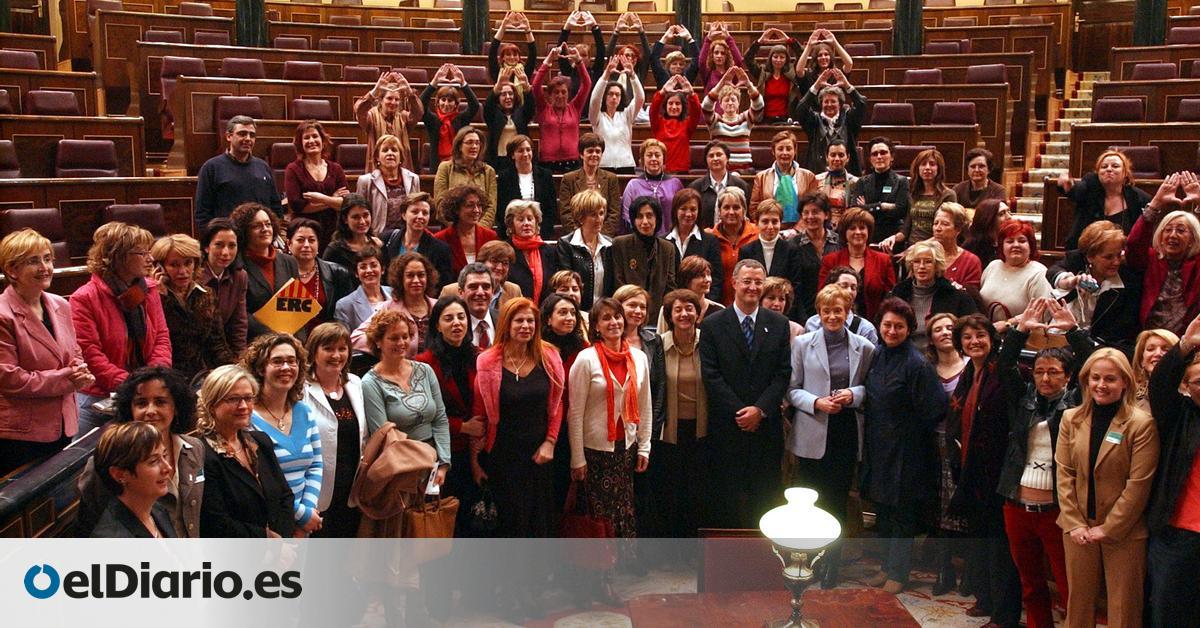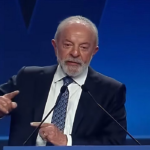
In 2004, 37 men and 3 women formed the Royal Academy of Language (RAE). In March of that year, the PSOE of José Luis Rodríguez Zapatero had won the elections with a promise: that the first norm that its Executive, the first joint in history, would send to Congress would be a law against gender violence. It thus included a demand from the feminist movement, which had been demanding comprehensive measures for more than a decade. But the RAE did not like the name.
Without anyone asking it, the cultural institution published a report in which it criticized the use of the word ‘gender’ and proposed that the norm be called “against domestic violence or violence based on sex.” Their unsolicited advice was ignored: Zapatero, pressured by women’s organizations, ordered that the law contain the expression ‘gender violence’. Thus was born a pioneering law that has made Spain an international reference: it was the first specialized law in all of Europe and delegations from dozens of countries continue to visit our country to learn up close how the different resources work.
“Every law has a before,” summarizes the socialist politician Micaela Navarro, who in the early 2000s held different positions related to equality and who led the bill against gender violence that the PSOE, still in opposition, presented. in 2001. That before is, fundamentally, feminism clearing paths. From the first feminist mobilizations after Franco’s death, the conquest of the right to abortion, divorce or employment, to care for women who suffered violence from their partners, the creation of the Women’s Institute and the construction of a speech that put on the social and political agenda an issue that until then was totally neglected and normalized.
We didn’t have a decent official statistic, it came late and poorly, it didn’t include the murders committed by the exes… We needed to size up the problem and we started counting to know the scope. It was a success, it allowed us to work better. We always tried to do a certain pedagogy
Charo Nogueria
— ‘El País’ journalist
In 1991, the Federation of Associations of Separated and Divorced Women, founded by the historic activist Ana María Pérez del Campo, managed to open its comprehensive recovery center for women, girls and boys. At the same time, resources in cities and autonomous communities were making their way thanks, above all, to the impulse of associations and feminists who had joined the ‘side’ of institutional and party politics. Throughout the decade, pressure grew for the Government to take action on the matter. The murder of Ana Orantes in 1997 was the definitive turning point: after appearing on television recounting the violence she had suffered, her ex-husband murdered her.
The Government of José María Aznar took several measures in this regard, such as the approval of protection orders for “victims of domestic violence.” However, the PP voted against the bill presented by the socialist group in 2001. “The women’s organizations managed to get the left to pick up the gauntlet.
Since the case of Ana Orantes, more social alarm was created, there is a change,” recalls journalist Charo Nogueira, a pioneer of information on equality, who worked in The Country. It was in that newspaper where, at the initiative of the Society section and in collaboration with Documentation, they created their own murder statistics in 2001 to address the lack of data.
There were three principles to take into account for the law to be effective: the centrality of women, due diligence to investigate, punish and repair victims, and the restitution of the life project.
Maria Duran
— feminist jurist
“We didn’t have a decent official statistic, it came late and poorly, it didn’t include the murders committed by the exes… We needed to size up the problem and we started counting to know the scope. It was a success, it allowed us to work better. We always tried to do a certain pedagogy,” recalls Nogueira, who explains that she and her colleagues chose to call the violence “sexist” “as opposed to the restrictive term” of domestic violence. In The Countryhe continues, there was no consensus to use the term ‘gender violence’ at that time. The coverage of journalists committed to the issue who worked in print media and on television managed to impact, for the better, the social debate.
The debates
In that first Zapatero cabinet, the feminist sociologist Soledad Murillo held the General Secretariat of Equality Policies in the Ministry of Labor and Social Affairs, the first political position specialized in Equality. With the Government formed, the drafting group of the future law began to work. Although they started from the bill that the socialist group had presented in Congress in 2001, not everyone agreed with all of its proposals. The name was one of the debates. The scope of action, another. Also whether or not to include the “instrumental purpose” of this type of violence. What they did not expect during its drafting was the number of constitutional issues that would later arise regarding the law. Up to 180.
Encarnación Orozco was part of that drafting group and says that, at first, they considered that the best choice was for the law to be ‘against violence against women’. “We believed that using gender could cloud the norm, make it not understood, we were in 2004 and the objective was to bring the law closer to the people to change the social fabric, which is ultimately what sustains this violence,” says Orozco. The term ‘sexist’ did not seem appropriate to them then either. What they were clear about was that the word ‘women’ had to appear in the plural, “to emphasize the substantiality of this norm, which is directed against women for the fact of being women and denotes this structural discrimination,” explains the one who She later became the Government’s first delegate against Gender Violence. The preposition ‘against’ was also a conscious choice: they wanted to make clear the intention of the rule, which was combative.
Charo Nogueira remembers that the news about the RAE report that criticized the choice of the word ‘gender’ caused a stir. Women’s organizations put pressure and, finally, the president agreed. “They wanted it to be clear that the ultimate cause was the roles, the gender, and they considered that it should appear that way from the beginning. It was a political decision taken directly by the president thanks to pressure from the associations,” confirms Encarnación Orozco. Among those key associations for the law to go ahead as it did was the Federation of Associations of Separated and Divorced Women, the Association of Women Jurists Themis, the Feminist Network against Gender Violence, or the Platform of Artists against Gender Violence .
We have verified how the gender perspective that the law introduced is used today to interpret the laws, the Constitution itself.
Immaculate Montalban
— former president of the Observatory against Domestic and Gender Violence of the Judiciary
One of the most critical issues was deciding what was the scope of the law’s expansion. “There were three principles to take into account for the law to be effective: the centrality of women, due diligence to investigate, punish and repair the victims and the restitution of the life project,” recalls feminist jurist María Durán. The drafting group specified that the law would focus on the crime committed by the couple or ex-partner to separate itself from the concepts of domestic violence and intrafamily violence, and although it named the women’s children in the preamble of the law, in that At first it did not include them as direct victims. “At that time it is true that the objective was to put women at the center and what we did do was put the seed with that mention so that in the future the recognition of minors as victims would arrive,” says Orozco. What they finally did not include was the mention of the “instrumental” nature of the violence to avoid that, in the trials, the accusations had to prove the sexist intention of the aggressors.
127 appeals admitted to processing
Once approved, at the end of 2004, all the organizations and changes contained in the standard had to be implemented. And no less than 180 unconstitutionality issues had to be faced, of which 127 were admitted for processing. “They gave us headaches, they are the obstacles to progress in equality,” says now the one who was then appointed the first delegate of the Government against Gender Violence, Encarnación Orozco. The current vice president of the Constitutional Court, Inmaculada Montalbán, who was president of the Observatory against Domestic and Gender Violence of the Judiciary, points out that this is one of the regulations that has received the most questions of unconstitutionality, but emphasizes that its legal imprint has been strong: “We have verified how the gender perspective that the law introduced is used today to interpret the laws, the Constitution itself.”
The machinery had to be put in place so that 016, the electronic control bracelets for the aggressors, the Viogén system, the specialized courts, the prevention plans, the institutional protection… There was nothing, it had to be done. all. My team and I were leaving when the ministry lights were already off.
Encarnacion Orozco
— drafter of the bill
The central criticism was that the law violated the principle of equality by contemplating aggravation of sentences for men in the case of injuries, mistreatment, threats and minor coercion. However, in 2008 the Constitutional Court endorsed the article that contemplated this change. Encarnación Orozco remembers that there were those who questioned other aspects, for example, including the withdrawal of the widow’s pension for the murderers of their partners. Because the rule, beyond the modification of the Penal Code, included education and prevention measures, in the workplace or in Social Security.
After its approval in December 2004, the machinery had to be put in place so that 016, the bracelets for telematic control of the aggressors, the Viogén system for assessing the risk of victims, the specialized courts, the prevention, institutional protection… “There was nothing, everything had to be done. My team and I left when the ministry lights were already off,” recalls Encarnación Orozco. The Government Delegation against Gender Violence also began to operate then: “We were able to forge that coordination network between ministries, distribute work between departments; Education, Justice, Interior, the coordination units of delegations and subdelegations of the Government…”.
What was the end of one story, the fight for Spain to have a comprehensive law, was the beginning of another: putting in place an entire system that would guarantee that the norm was more than just a piece of paper. From then until now, 20 years later, there have been changes, improvements, expansions, criticisms. Despite the threats, the push and pull between advances and setbacks, Spain is different. Of course, two decades later, in the RAE there are 33 men and eight women.
Source: www.eldiario.es

